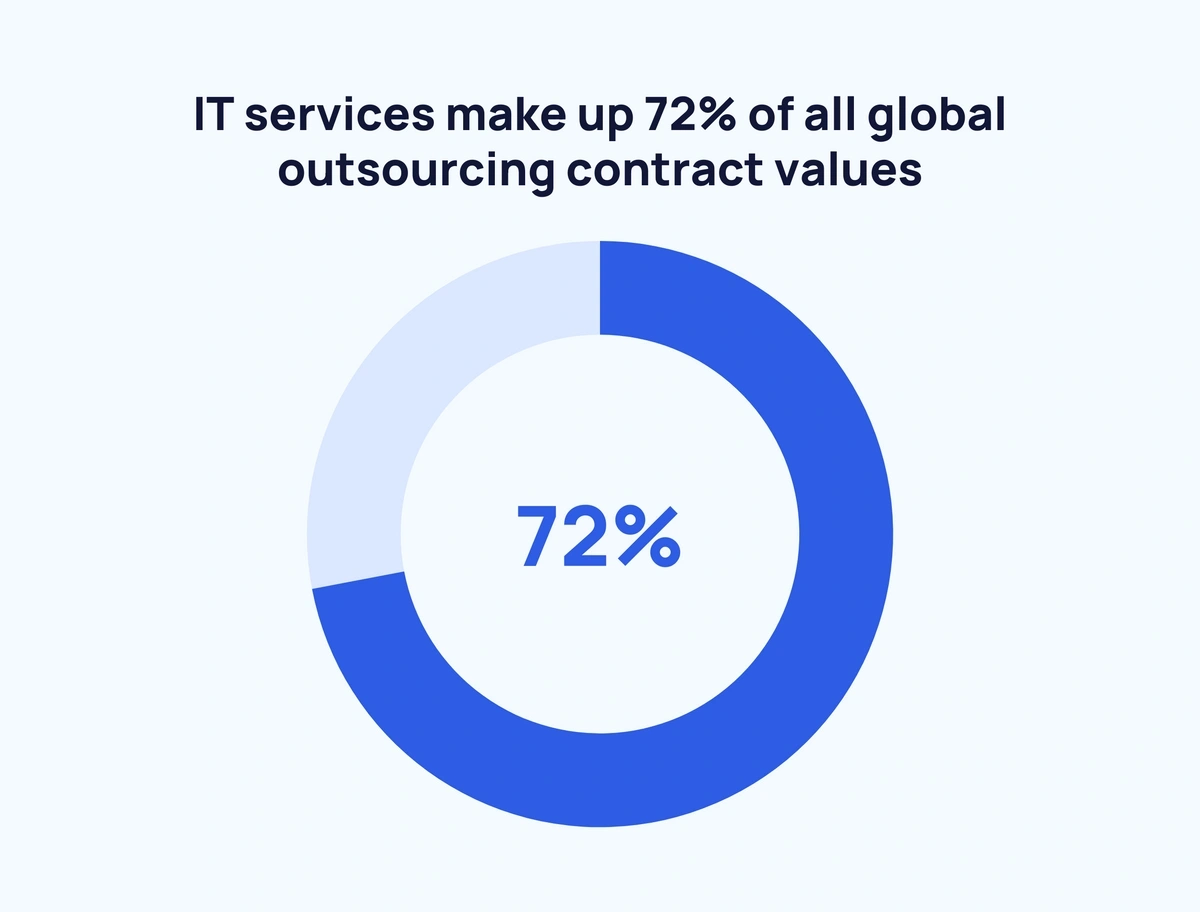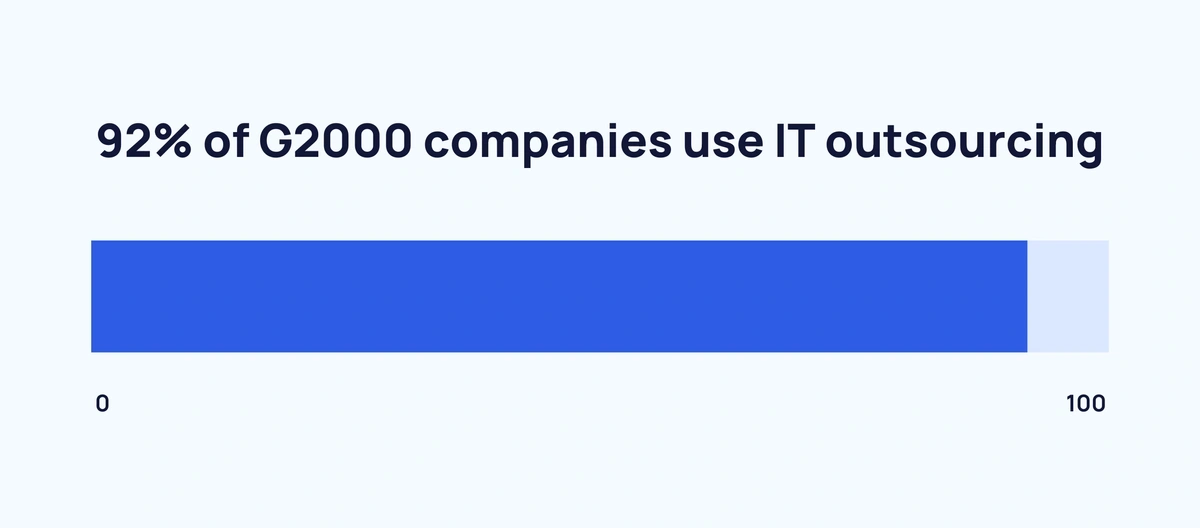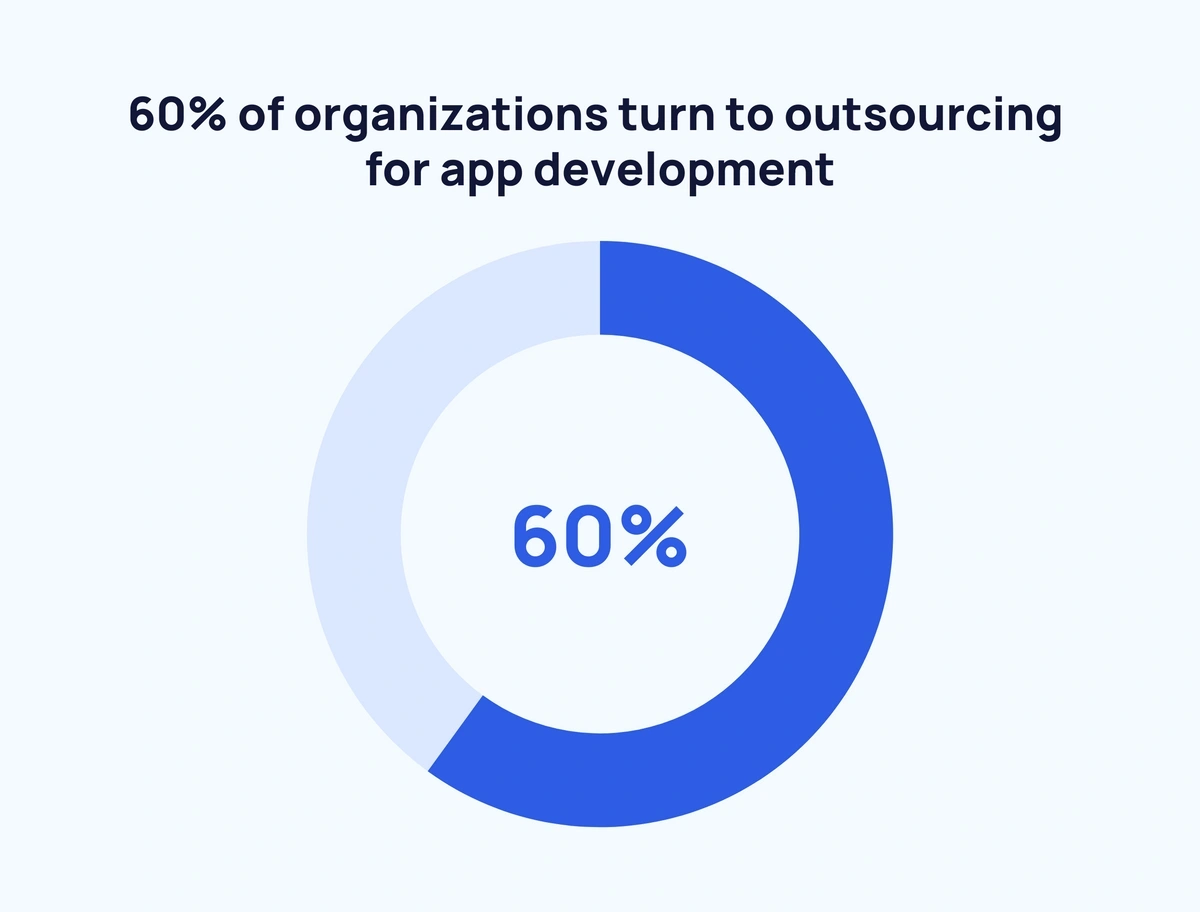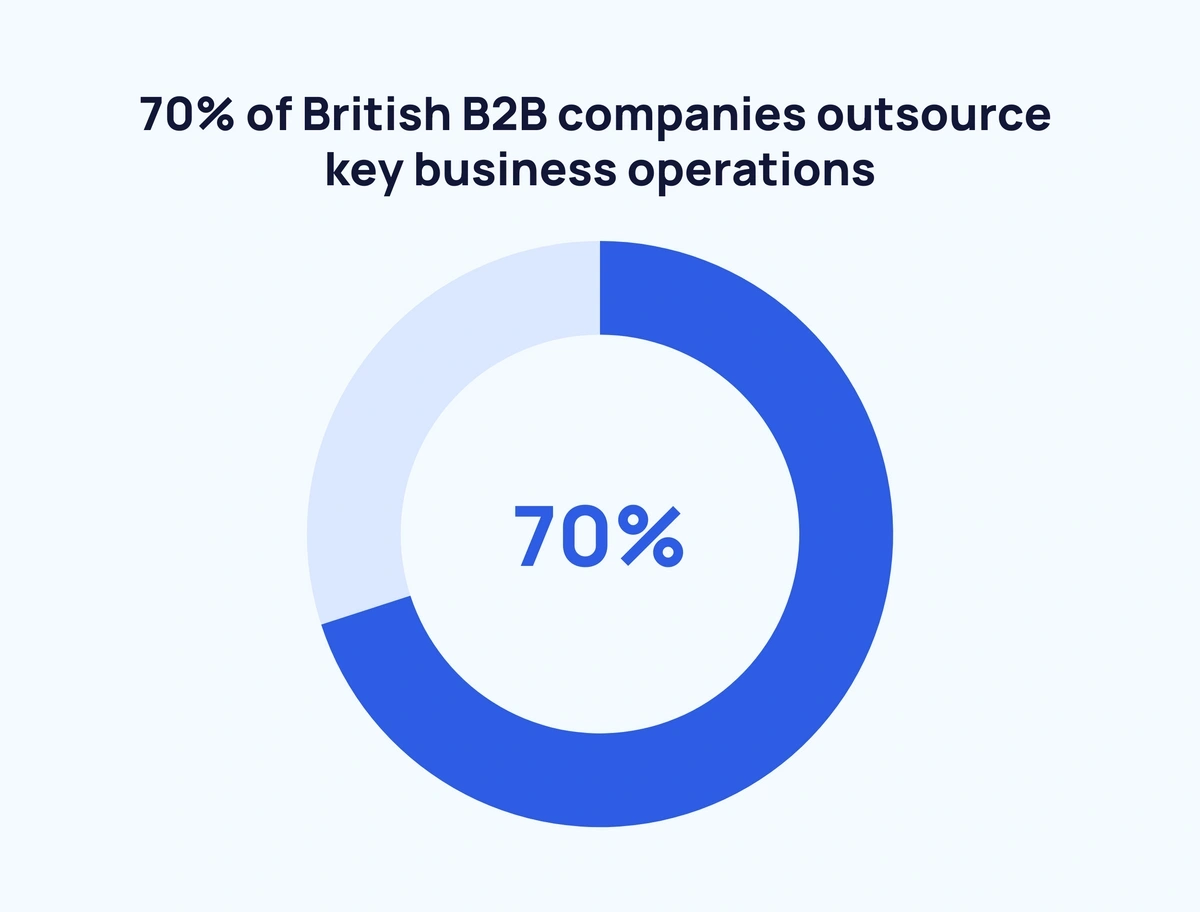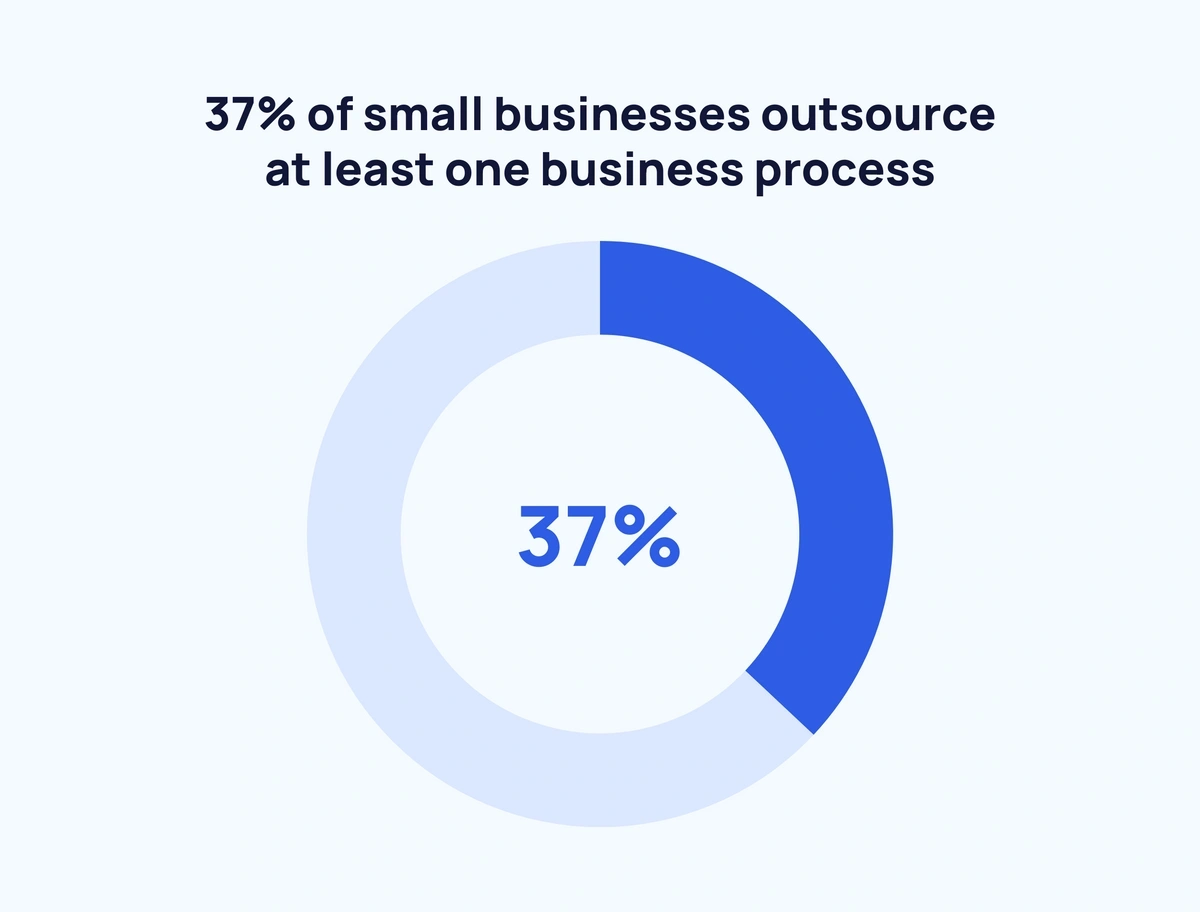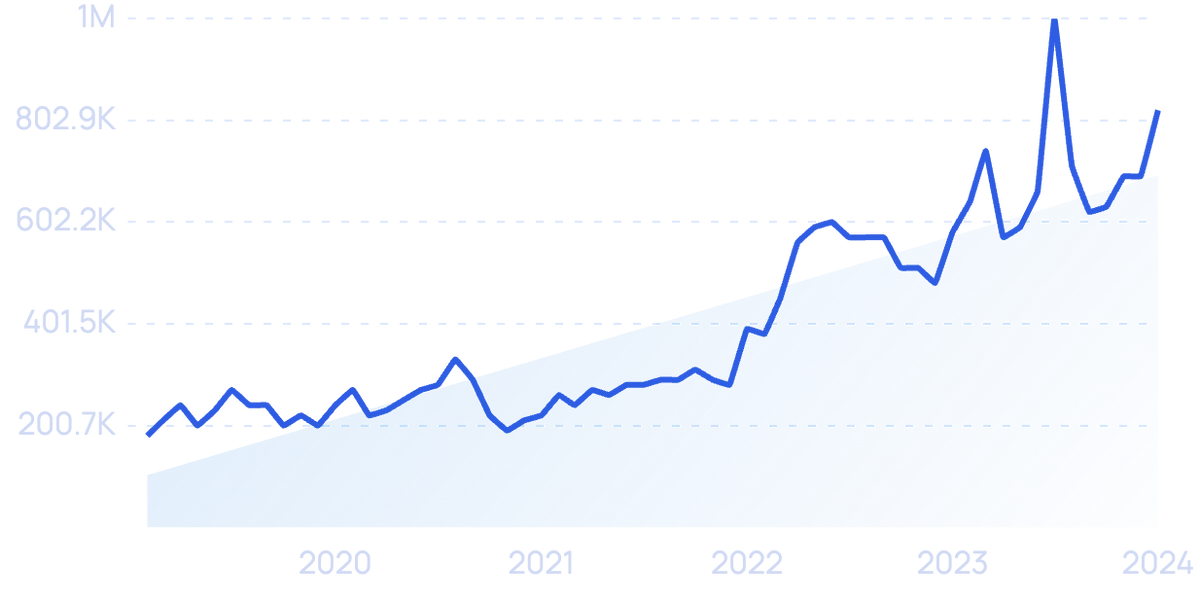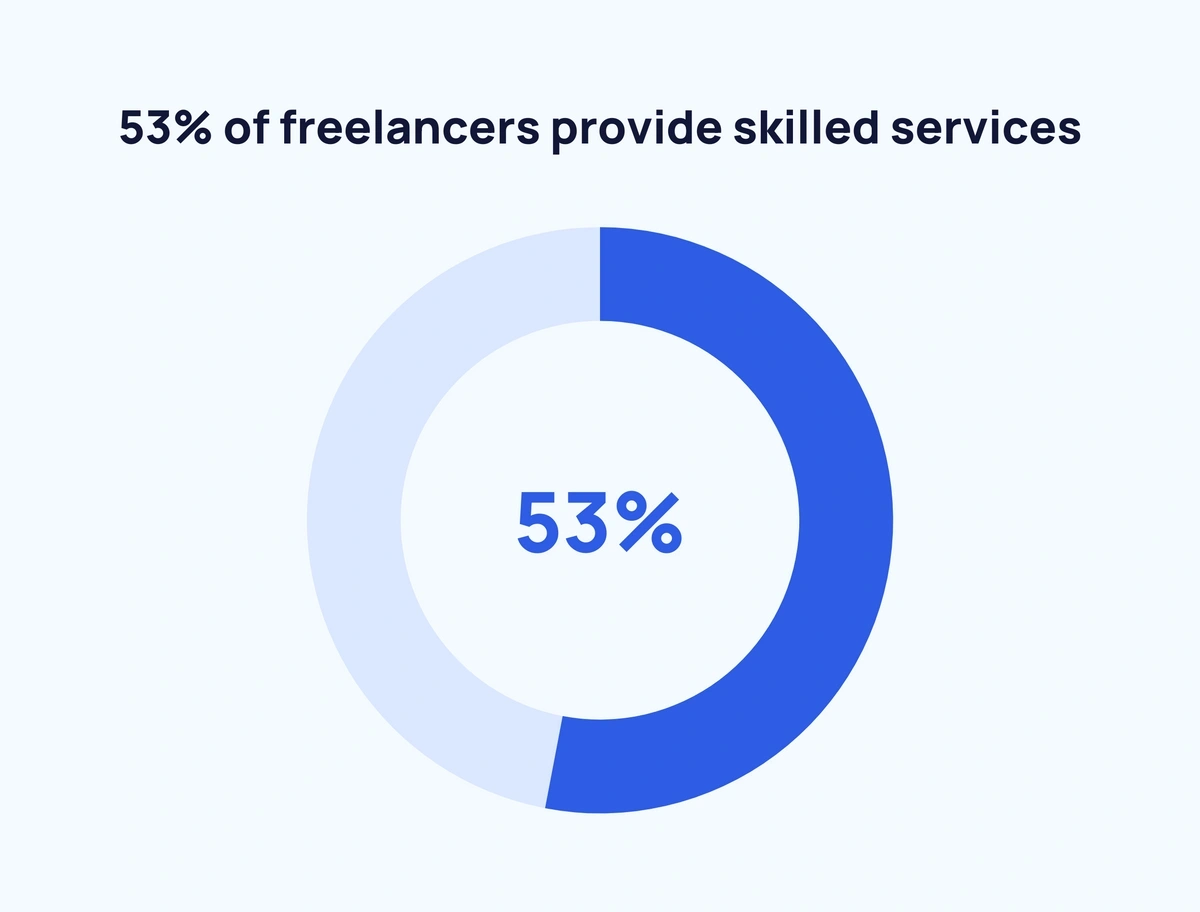
47 New Outsourcing Statistics (2025-2027)
Cutting costs and improving efficiency are two of the most critical elements of running a successful company.
For a large number of organizations, outsourcing lets them check off those boxes and more. By offloading specific business operations to outside firms, companies can save on payroll and training. They also free up their staff to focus on core business functions.
Outsourcing is truly a global industry. American corporations routinely send customer service and IT jobs offshore, where they can get the same outcomes for a fraction of the cost. For some developing nations, performing outsourced work represents a large portion of their economies.
So what is the state of outsourcing in 2025? Keep reading to find out.
Contents
- Top Outsourcing Statistics
- Outsourcing Market Statistics
- General Outsourcing Statistics
- Global Outsourcing Statistics
- Small Business Outsourcing Statistics
- Freelancing Statistics
Build a winning strategy
Get a complete view of your competitors to anticipate trends and lead your market
Top Outsourcing Statistics
Before you dive into the full list, here are the most eye-opening outsourcing statistics:
- Global business processing outsourcing will reach $525 billion by 2030.
- 92% of G2000 companies use IT outsourcing
- 9% of the Philippines’ GDP comes from business process outsourcing
- 37% of small businesses outsource at least one business process
- Over one million new employees join the services outsourcing industry in China each year
Outsourcing Market Statistics
The global outsourcing market is dominated by two sub-industries: IT outsourcing (ITO) and business process outsourcing (BPO).
ITO includes things like cloud computing services, web hosting, cybersecurity and data backups.
BPO contains a multitude of functions including payroll and other HR services, marketing, customer service and logistics.
The global business process outsourcing market is expected to reach $525 billion by 2030 (Grandview Research)
Business process outsourcing is projected to grow by over 9% per year between now and 2030. The financial services, IT, and telecommunications industries are expected to be the biggest drivers behind that growth.
The global outsourcing market is worth $92.5 billion in total contract value (TCV) (ISG)
The global outsourcing market value peaked at $104.6 billion in 2014 before hitting a ten-year low of $76.9 billion in 2016. Since then the market has recovered, growing 20% between 2016 and 2019.
IT services make up around three-quarters of all global outsourcing contract values (ISG)
Of the $92.5 billion in contracts generated by global outsourcing firms, $66.5 billion came from information technology (IT) services. Business process outsourcing made up the remaining $26 billion in total contract values.
60% of finance and accounting outsourcing contracts won’t be renewed by 2025 (Gartner)
Outdated pricing models are leading finance and accounting companies to reexamine their outsourced contracts. As outsourced processes become more and more automated, traditional “headcount-based” pricing models have largely become costly and obsolete.
General Outsourcing Statistics
Which factors do companies make when deciding whether to outsource? These statistics explore how and why companies outsource their various business operations.
92% of G2000 companies use IT outsourcing (ISG)
Over 9 in 10 of the top 2000 global companies had IT outsourcing contracts in 2019. Business process outsourcing was less popular than IT, with only 59% of G2000 companies having a contract.
90% of companies consider cloud computing as a key enabler in their outsourcing efforts (Deloitte)
More and more companies are striving to become “cloud first,” a trend that’s been accelerating since the start of the COVID-19 pandemic. While the vast majority of companies recognize the benefits of a cloud-first model, data security and other risks are hurdles in making the transition.
83% of IT leaders are considering outsourcing their security efforts (Syntax)
A combination of budget cuts, staff reductions, and increased cyber threats are leading IT teams to seek outside solutions for cybersecurity. While 91% of IT professionals have their own in-house security teams, 83% are looking at outsourcing security moving forward.
3 in 5 organizations turn to outsourcing for app development (back4app)
App developers have specialized knowledge and command high salaries, making app development a key area for outsourcing. Outsourcing rates vary across industries. In the financial services sector, 72% of organizations outsource app development. In healthcare, that number drops to just 31%.
Companies that outsource HR can save an average of 27.2% (NAPEO)
Companies that hire PEOs — professional employer organizations — can cut costs by outsourcing HR functions like hiring, recruiting, compliance, and managing unemployment claims. A study by NAPEO found that the average cost savings from hiring a PEO can lead to a 27.2% ROI.
The number of marketing professionals outsourcing content marketing tasks fell 25% between 2019 and 2020 (Statista)
Outsourcing content marketing fell out of favor between 2019 and 2020. In 2019, 40% of marketing professionals outsourced some content marketing, while in 2020 that number fell to 30%. The top outsourced content marketing tasks were writing, graphic design, video design, and animation.
Google searches for “content writing” are up 113% over the past 5 years.
Strong problem solving skills is the most important factor for small businesses choosing an outsourced team (Upcity)
The ability to approach business challenges in new and creative ways is the top selling point for outsourced teams among small businesses. Problem solving skills even edged out years of experience, overall cost and online reviews in Upcity’s 2022 poll.
“Enabling focus on core functions” is the most common perceived benefit among companies that use outsourcing (Deloitte)
In Deloitte’s Global Outsourcing Survey, respondents were asked “How does your organization perceive the benefits of outsourcing?” 65% said outsourcing helps them focus on core functions. 63% mentioned cost-cutting as a key benefit of outsourcing.
Global Outsourcing Statistics
With global connectivity at an all-time high, companies can outsource work to firms all over the world. Organizations leverage highly skilled, low cost labor overseas to cut costs and streamline operations.
If you want to learn more about top outsourcing companies, check out of list of top websites in the outsourcing industry.
Want to Spy on Your Competition?
Explore competitors’ website traffic stats, discover growth points, and expand your market share.
India is the most attractive country for outsourcing business services (Kearny)
The Global Services Location Index (GSLI) is a tool for measuring a country’s attractiveness for outsourcing business services. It factors in financial attractiveness, people skills and availability, business environment and digital resonance. India had the highest GSLI score in 2021. In fact, 7 of the top 10 countries are in the Asia-Pacific region: India, China, Malaysia, Indonesia, Vietnam, Philippines, and Thailand.
9% of the Philippines’ GDP comes from business process outsourcing (Matchboard)
Approximately one million Filipinos work outsourced jobs, an industry that’s worth close to $27 million and makes up almost a tenth of the country’s economy. The Philippines’ 97% literacy rate and low minimum wage (a Filipino graduate earns around $300 per month) help attract companies looking to move business functions offshore.
Companies that outsource to the Philippines can cut labor costs by 70% (OutsourceAccelerator)
The Philippines has two big selling points for companies looking to outsource: a highly capable workforce and a low cost of living. For example, the average salary for Filipino software developers is just $7,174. That’s around 10% of $69,589 — the average salary of an American software developer.
The service outsourcing industry in China is worth over $175 billion (Statista)
China’s outsourcing industry was valued at $175.35 billion in 2020. That’s a 65% increase over its 2016 market value of $106.46 billion.
Over one million new employees join the services outsourcing industry in China each year (Statista)
The Chinese services outsourcing industry has shown consistent growth since 2016. Around 5,000 new outsourcing companies have been formed each year in addition to the million new jobs created annually.
The BPO market in Japan is expected to reach $38 billion by 2025 (Statista)
The Japanese business process outsourcing market has shown slow but steady growth since 2018. While it’s only grown at a modest 2.28% CAGR, it generates trillions of Yen in sales value each year.
7 in 10 British B2B companies outsource key business operations (YouGov)
34% of B2B organizations in the UK outsource IT support, making it the UK’s most commonly outsourced service. Other key outsourced services are payroll (28%), printing (24%) and accounting (24%).
Small Business Outsourcing Statistics
Small businesses outsource for a number of reasons. The decision to outsource often comes down to which approach is most cost-effective. In other cases, companies outsource to gain access to specialized skills they can’t tap from within.
Over 1 in 3 small businesses outsource at least one business process (Clutch)
Over one-third of small businesses in 2019 outsourced a portion of their business processes. On top of that, over half (52%) said they plan on outsourcing at least one business process in the foreseeable future.
Accounting and IT services are the most popular outsourced processes for small businesses (Clutch)
37% of small businesses outsource both accounting and IT services. Other common business functions small businesses outsource are digital marketing (34%), development (28%), human resources (24%) and customer support (24%).
Nearly one-quarter of small businesses say they outsource to increase efficiency (Clutch)
Outsourcing lets small businesses leverage their talent by offloading mundane tasks like coding or data entry. 24% of small businesses polled by Clutch said increased efficiency was their top reason for outsourcing. Other reasons include increasing available expertise (18%), flexibility (16%) and allowing employees to perform other tasks (15%).
Cost is the biggest challenge for small businesses looking to outsource (Upcity)
Upcity’s 2022 poll of 600 US and Canada-based small businesses found that 23% of small businesses consider high costs the biggest challenge in working with an outsourced team. Other challenges were more interpersonal — 21% said outsourced teams were difficult to communicate with, 14% said teams failed to meet deadlines and 12% said teams didn’t follow instructions.
Small organizations are more likely to outsource payroll services than large organizations (Statista)
15% of organizations with 2,500 or fewer employees fully outsource their payroll services. On the other hand, only 8% of organizations with 10,000 or more employees do the same. Meanwhile, HR software solutions like Rippling are making it easier for organizations to administer payroll without sacrificing efficiency.
Google searches for “rippling” have increased by 356% over the past 5 years.
Freelancing Statistics
For skilled or creative work, many companies turn to individual freelancers. The rise of freelancing over the past several years is sure to have an impact on the future of outsourcing.
Over 50 million Americans perform some kind of freelance work (MBO Partners)
The number of independent workers in the US increased by 34% from 2020 to 2021. Of the 51.1 million Americans working independently, 17 million are full-time independent contractors. Interest in freelancing has shot up since the beginning of the COVID-19 pandemic.
Google searches for “freelancing” are up 300% over the past 5 years.
Freelancers make up 38% of the American workforce (Upwork)
The pandemic and the “Great Resignation” pushed more Americans to start freelancing in 2021. All together, freelancers contributed $1.3 trillion to the US economy. This number will likely grow, as 56% of non-freelancers say they’re considering freelancing in the future.
Currently, the majority of freelancers work on platforms like Upwork, Fiverr, Freelancer, Toptal, and FlexJobs. Here's a comparison of the top freelancing platforms based on user and Semrush traffic data:
| Platform | Total Users | Total Monthly Visits |
|---|---|---|
| Upwork | 18 million | 49.5 million |
| Fiverr | 4 million | 69.9 million |
| Freelancer | 60 million | 7.4 million |
| Toptal | 25,000 | 2.9 million |
| FlexJobs | 10 million | 7.5 million |
Over half of freelancers provide skilled services (Upwork)
Skilled workers are going freelance in record numbers. 51% of workers with postgraduate degrees perform some kind of freelance work — many in the skilled services category. Skilled services include computer programming, marketing, IT services, and business consulting.
Wrap Up
As you can see from these statistics, outsourcing is used by companies of all sizes and across all industries. Organizations spend hundreds of billions of dollars every year offloading part of their workflows to outside firms. At the same time, firms are finding ways to perform outsourced work in less time and for less cost.
While outsourcing’s huge footprint means many jobs in developed countries are moved offshore, developing nations get an economic boost from outsourced work.
In fact, in many developed countries, an increasingly large percentage of professionals are turning to independent freelance work, adding yet another dimension to the outsourcing landscape.
If you enjoyed the outsourcing stats, take a look at these related pages: 7 Remote Work Trends and 8 Huge Cybersecurity Trends.
Stop Guessing, Start Growing 🚀
Use real-time topic data to create content that resonates and brings results.
Exploding Topics is owned by Semrush. Our mission is to provide accurate data and expert insights on emerging trends. Unless otherwise noted, this page’s content was written by either an employee or a paid contractor of Semrush Inc.
Share
Newsletter Signup
By clicking “Subscribe” you agree to Semrush Privacy Policy and consent to Semrush using your contact data for newsletter purposes
Written By


Josh is the Co-Founder and CTO of Exploding Topics. Josh has led Exploding Topics product development from the first line of co... Read more

